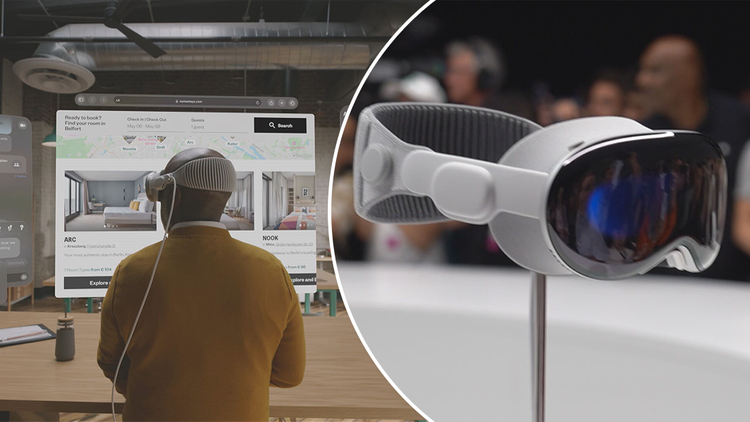Apple’s highly anticipated Worldwide Developer Conference in Cupertino, starting on June 5, is expected to unveil the tech giant’s inaugural VR headset. This release marks Apple’s most significant product introduction since the Apple Watch was launched eight years ago. However, industry analysts predict that the VR headset will not achieve the same sales figures as Apple’s previous wearable devices.
Numerous details about the headset have surfaced in recent months. It is likely to be named Reality One or Reality Pro and will operate on a customized version of iOS called xrOS. With an estimated price tag of $3,000, the headset will offer consumers a lightweight design reminiscent of ski goggles. Unlike other VR devices, it will not require a computer or phone to run immersive apps. Instead, it will rely on an external battery pack, conveniently carried in a pocket and connected via a short cable.
The headset will be equipped with outward-facing cameras capable of live-streaming the user’s surroundings directly into the headset. This mixed reality approach enables the combination of virtual elements with the real world. Users will reportedly be able to switch effortlessly between a view of their surroundings and complete VR immersion using a physical dial or button.
The device is expected to support a wide range of first- and third-party virtual reality apps, encompassing games, fitness and meditation applications, as well as the ability to watch movies, sports, and live events in VR. Users will likely have access to existing iPad apps, including various apps and services developed by Apple.
One notable differentiating feature of the headset, according to several reports, is the inclusion of an outward-facing display that shows the wearer’s facial expressions to those nearby. This feature aims to enhance social interaction and reduce the isolating nature of wearing a VR device. Additionally, the ability to conduct FaceTime calls with users of phones, tablets, and computers may be highlighted during the product launch.
Despite these features, it remains uncertain whether these factors will convince a large number of Apple enthusiasts to purchase the headset. The high price and lack of a clear focus may hinder sales. Moreover, the recent announcement of the more affordable Meta Quest headset, set to launch in the fall, further complicates the market landscape. Apple has reportedly adjusted its initial sales expectations from 3 million to only 900,000 units, according to a Bloomberg report.
However, critics may want to reconsider labeling Apple’s entry into the VR market as a blunder. The VR market has experienced significant growth in recent years. Meta, a major player in the industry, has sold approximately 20 million Quest 2 VR headsets since late 2020, with the Quest app store generating over $1.5 billion in app and game sales. Out of the 500-plus titles available on the Quest store, 40 have surpassed $10 million in sales. Notably, popular titles like “Beat Saber” have generated revenues in the nine-figure range.
It is important to recall that many of Apple’s best-selling products initially faced slow adoption rates. For instance, the Apple Watch sold a mere 10 million units in its first year, falling far short of the company’s internal goal of 40 million units. However, four years later, the Apple Watch surpassed the entire Swiss watch industry in sales.
Even the iPhone, now a global success, did not achieve immediate popularity. In its first year on the market, Apple sold only 1.4 million units, and sales remained below 12 million in the subsequent fiscal year. Today, the iPhone has propelled Apple to become the world’s most valuable company, boasting a global smartphone market share of 25%.
Whether Apple can replicate these triumphs in the emerging VR market ultimately hinges on the company’s ability to differentiate itself from competitors, identify market needs, and target specific use cases. Accomplishing these goals will require Apple to embark on a multiyear journey, continuously improving and making their VR devices more accessible and affordable over time. The upcoming Worldwide Developer Conference will mark Apple’s initial step into this exciting new realm.
Janko Roettgers, an esteemed author who specializes in exploring the future of technology and entertainment, shares his insights through his weekly newsletter called Lowpass. Formerly a senior reporter for Variety and Protocol, Roettgers contributes his expertise to reputable publications like Fast Company and The Verge. On June 15, he will publish a special report titled “Getting Real About VR” on the Variety Intelligence Platform, delving deeper into the intricacies of the VR landscape.
In conclusion, Apple’s much-anticipated VR headset is set to make its debut at the Worldwide Developer Conference. While its sales may not reach the levels of previous wearable devices, the VR market has shown significant growth, presenting an opportunity for Apple to carve its path to success. By introducing innovative features and addressing market needs, Apple has the potential to revolutionize the VR industry, much like it did with the Apple Watch and iPhone. Only time will tell if Apple can dominate the nascent VR market, but their first step into this realm marks the beginning of an exciting journey.
